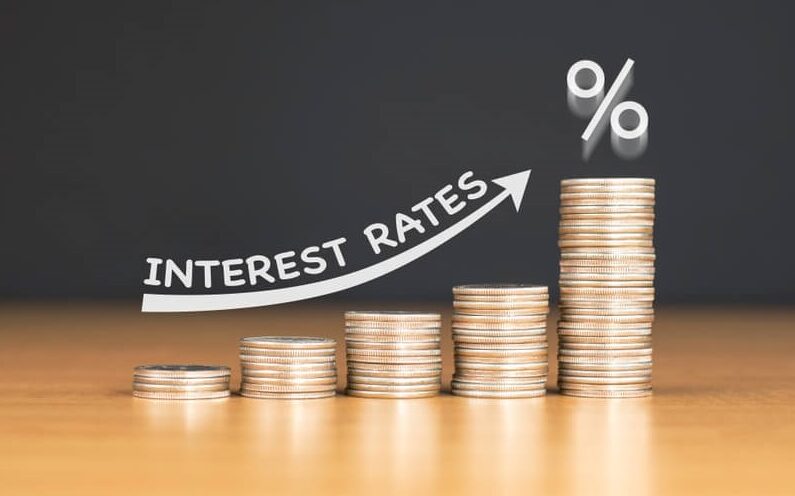The Federal Open Market Committee raised its benchmark interest rate by 0.25% yesterday.
It was the Fed’s first rate hike since 2018, and we could see six more in 2022 as the central bank aims for a 1.9% funds rate target by year’s end.
The market’s known it was coming for months. But where do we go from here?
In this week’s Investing With Charles, Research Analyst Matt Clark and I hash out a plan for the future as the central bank considers more rate increases to fight inflation.
Here are the highlights of my conversation with Matt. (Note: This video was recorded before the Fed’s announcement on Wednesday.)
Fed Chair Powell Is a Straight Shooter
Charles: I want to start by talking about how current Fed Chair Jerome Powell has handled the economic situation throughout the global pandemic.
By his own admission, Powell screwed up policy.
He came out in a recent interview and basically said, “Yeah, we should have started raising rates earlier. We should have tightened earlier. We were a bit behind the eight ball on that, and this is where we are today.”
But I will say this about Powell: He’s not a man of surprises. He doesn’t like to keep you guessing.
This is almost financial blasphemy, but I always hated Alan Greenspan because he spoke in this coded language that was so opaque and hard to understand. You could have three people watch a Greenspan speech, and they would each have a different answer regarding what he actually said.
Powell is straightforward. He tells you exactly what he’s thinking and what he’s planning to do. He doesn’t want any surprises.
It’s almost radical honesty here. He’s just laying it out for you, and I appreciate that.
The Fed’s Challenge
Charles: Now the dynamic Powell’s up against is the Fed’s dual mandate.
The central bank aims to keep inflation under control, but it’s also supposed to guarantee a growth economy with full employment.
These two interests are often at odds.
It’s worked out that as a general rule, we’ve been able to keep interest rates lower than most economists would’ve thought prudent for a long time without stoking inflation.
When I say a long time, I mean 20 years. We are kind of hitting the end of that rope.
Inflation is an issue for now. How did the Fed curb rising prices in the past?
Back in the 1980s, Fed Chair Paul Volcker played the bad cop.
President Ronald Reagan gave him the green light to kill inflation even if it sent the U.S. economy into a recession.
So Volcker hiked rates up to what would be considered almost a ridiculous level today. Rates peaked around 20% in 1981!
But it worked. It broke the inflation of the 1970s. We went through a long stretch of disinflation that persisted until recently.
Now Powell has some difficult choices.
And as investors, we want to know what his forward guidance looks like.
How Many Interest Rate Hikes Will We See in 2022?
Matt: Right now, analysts expect between two and five interest rate hikes in 2022.
There's a big difference between two rate hikes in a year and five rate hikes in a year.
In the chart [above], you can see the Fed hiked rates at a rapid pace in the mid- to late-1980s and again in the mid-1990s and again around 2005.
Looking at the last time the Fed hiked rates in the late 2010s, it was much more gradual.
Will we get a more gradual interest rate hike or should we prepare for a meteoric rise?
Charles: A couple of thoughts on that.
Why was the rate hike trajectory a lot less steep the last go-around right before the pandemic?
It goes back to 2008.
The financial crisis was such a jarring experience for capital markets and for the Fed that the central bank was scared.
Officials were scared of their own shadow for 10 years after the 2008 meltdown.
They were reluctant to normalize policy because they were so afraid that the financial system wasn’t ready for it.
In hindsight, that’s ridiculous.
Two years after 2008, they should have at least tiptoed toward raising rates a little bit. But then the European sovereign debt crisis happened.
And then there was the fear that Italy was going to default. So that was a very timid period for the Fed.
The Fed said, “Look, we still don't see inflation so we're just going to keep rates low as long as possible until something makes us move.”
Now we're sort of paying the price for that. Accommodative policy contributed to the higher inflation we see today.
And that means we’ll be fighting some pretty significant headwinds for the foreseeable future here.
How to Invest After the Fed's Interest Rate Hike
Charles: This year we've had a scenario where stocks and bonds have been falling. Bond yields have been rising, which means prices have been falling.
It's hard to make money when your primary investment vehicle, stocks, is doing poorly, but then your hedge, your bonds are also doing poorly.
That's not to say that you can't make money. I believe you can. It's just not going to be as easy as it was.
Matt: What can investors do to — I guess not to guard against a rate hike — but maybe be more advantageous with a rate hike?
Charles: There's a couple things I would suggest.
First, you don't have to be fully invested all the time.
There's no ironclad rule of the universe that says 100% of your portfolio has to be invested.
You can keep some of your portfolio in cash, and you should.
Keep a little bit more cash on hand than usual. If you normally keep 5% in cash, maybe up that to 10% or 15%. If you usually keep 10%, maybe go to 20%.
Just keep a little bit more in cash so that you can be tactical, which is my second suggestion.
Be tactical.
Look for those kind of short-term, mean reversion traits. If you see that stocks have fallen too far too fast, you can make short-term bets that they bounce.
It could be just a multi-day or a multi-week trade. That’s fine.
And then look outside of the traditional stock market.
We've done really well in Green Zone Fortunes looking at commodity plays, for example. And I think that's a great place to be so long as inflation is high, and we have a negative environment for stocks and bonds.
Where Inflation Goes From Here
Matt: The 12-month basis of inflation is at 7.9%. It's the highest we’ve seen in 40 years.
There's no quick way to reverse that. We won’t see that number back down to 2%, which is the Fed’s target, overnight.
Charles: No, it ticks down over time.
I've been saying for a while that inflation will be transitory. The war in Ukraine stretches my time frame a little bit.
But all the same, you don't go from almost 8% inflation back to the targeted 2% inflation in a day.
It goes from seven to six, five, four … it's a countdown. And I wouldn’t be surprised if it was like a sawtooth, where it’s kind of choppy on its way down.
It’s going to take months or even years.
Note: I mentioned getting tactical earlier with your investing earlier.
If you are looking for ways to invest in some of the biggest mega trends driving markets, you should check out my colleague Adam O'Dell's Green Zone Fortunes.
His recommendations are focused on shorter-term holdings (2-3 years), and he has high-conviction picks across many trends including biotech, infrastructure and artificial intelligence.
His latest presentation is focused on a tech he calls "Infinite Energy."
A tiny Silicon Valley company is targeting the largest untapped energy source in the world. Its technology will disrupt the global energy space worth trillions of dollars.
And it has the potential to make its early investors a lot of money.
Click here to watch Adam's presentation now and see the details on how you can join Green Zone Fortunes today!
Where to Find Us
Coming up this week, Matt will have more on The Bull & The Bear podcast, so stay tuned.  Don’t forget to check out our Ask Adam Anything video series, where Chief Investment Strategist Adam O’Dell answers your questions.
Don’t forget to check out our Ask Adam Anything video series, where Chief Investment Strategist Adam O’Dell answers your questions.
You can also catch Matt every week on his Marijuana Market Update. If you are into cannabis investing, you don’t want to miss Matt’s weekly insights.
Remember, you can email my team and me at Feedback@MoneyandMarkets.com — or leave a comment on YouTube. We love to hear from you! We may even feature your question or comment in a future edition of Investing With Charles.
To safe profits,
Charles Sizemore, Co-Editor, Green Zone Fortunes
Charles Sizemore is the co-editor of Green Zone Fortunes and specializes in income and retirement topics. He is also a frequent guest on CNBC, Bloomberg and Fox Business.






